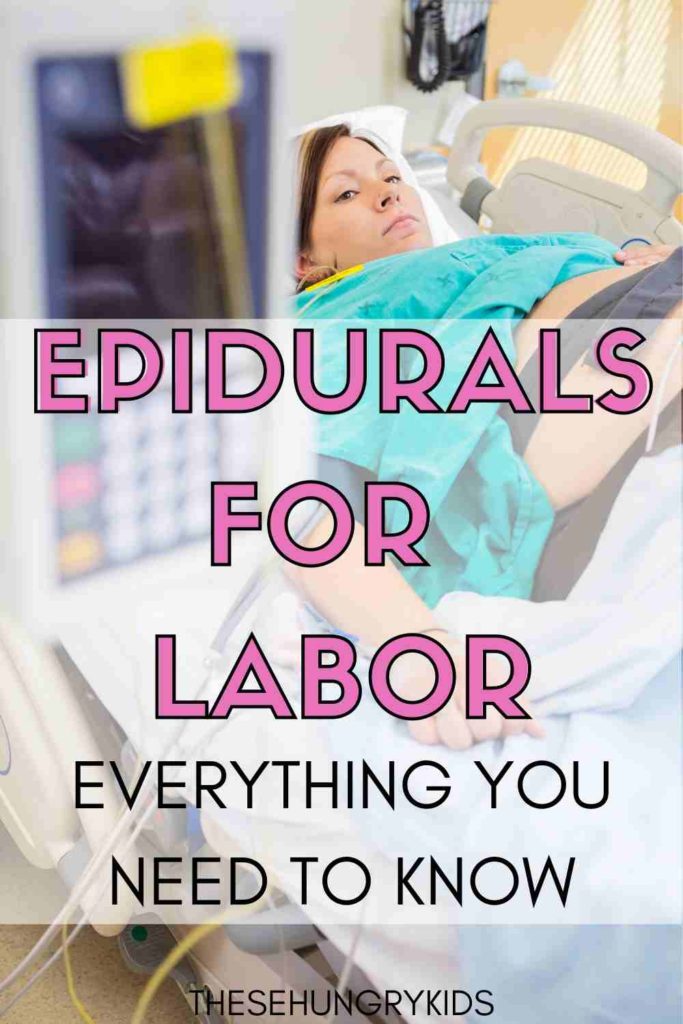If you’re looking to give birth pain free, you’re likely interested in epidural injections. What what exactly is it, and what is the epidural procedure?
Epidurals are an extremely safe and effective way to relieve pain in labor! In fact, a study done by Stanford University showed that nearly 71% of pregnant patients in the United States opted for an epidural birth.
There are some regional differences to who opts for an epidural as well. According to this article, people in Nevada are more likely to get an epidural, while the rates are lowest in Maine.

There are many common myths surrounding epidurals that may make you afraid to get one, but the fact of the matter is that the risk of complications is extremely small to the mother, and a minute amount of medication passes to the baby.
In fact, when compared to other pain medication options used to relieve pain in labor, an epidural affects the baby the least. But opinions aside, here are the facts about getting an epidural for labor pain relief.
Disclaimer: The information in this post is purely for entertainment and is not meant to replace the advice of a medical professional. I always adhere to HIPPAA policies, any similarities to yours or anyone else’s story is purely coincidental. Please see my disclosure policy for more information.

What is epidural analgesia?
Epidural analgesia is a fancy way to say “pain relief from an epidural block.”
Placed by an anesthesiologist or a nurse anesthetist, an epidural is a small catheter, or tube, that gets placed through the lower back into the epidural space. Then, a small amount of medication is administered through that tube to block pain signals to your lower body.
Epidurals are great for relieving contraction pain, but they typically do not get rid of the pressure of the baby’s head as it enters the birth canal.
This pressure is intense and uncomfortable, but it is not nearly as uncomfortable as the pressure paired with the contraction pain!
So while you may be uncomfortable towards the end of labor with an epidural, it definitely helps in making the situation better.

Epidural vs. spinal block
An epidural is different from a spinal block. With a spinal block, medication is injected into the dura mater to numb the spinal nerves. With a spinal, you are instantly numb and unable to move the lower part of your body. With an epidural, it takes longer to feel pain relief and you’ll likely feel slight pressure sensation and have some mobility.
Spinals are often used for cesarean section instead of general anesthesia. Typically you are only put to sleep for a c-section if it is an emergency situation.
However, an additional bonus of having an epidural placed is that it can be used to numb you for a c-section if necessary. Your anesthesia team can give you a big dose of numbing medication if you needed a cesarean delivery.

The epidural process step by step
If an epidural is going to be part of your birth plan, you’re probably wondering how it’s going to go. This is the process for getting your epidural anesthesia set up.
Step one: consent and preparation
First, the anesthesiologist or nurse anesthetist will come and introduce themselves to you. They will discuss all of the benefits and risks to you, and at the end they will ask if you would still like an epidural. This is called getting informed consent.
They will do a thorough exam and as about your health history to make sure an epidural is a good fit for you.
One of the possible side effects of epidural medications is low blood pressure. Certain medical conditions may make you more likely to experience this. To prevent this from happening, you may need to receive a few bags of IV fluids before the epidural placement. Your healthcare provider can give you additional medication to improve your blood pressure if it were to drop.
Step two: getting positioned
You will be instructed to either sit on the edge of the bed, with your feet hanging off the side, or to lie down on one side and curl into the fetal position for the epidural placement. The anesthesia team and your nurse will help you get into the right position for your epidural.

Step three: cleaning and prepping the area
Once you are positioned, they will clean your back off with soap. Next, you’ll feel the anesthesiologist pushing around on your back between your vertebrae. He/she is trying to find the perfect spot to place your epidural so that you are numb in all the right areas.
Step four: numbing medicine
When the anesthesiologist finds the spot to place the epidural, they will inject some numbing medicine called local anesthetic. This is the only part of the epidural placement that should hurt!
The local anesthesia feels like a quick sting. After that, all you should feel is the pressure as they place the epidural needle.
A few seconds after the numbing medicine is injected, that area of your back should be numb.
Step five: placing the catheter
The anesthesiologist will then place a needle between the vertebrae into the epidural space of your back. The epidural space is the space between your vertebrae and your spinal cord.
Once they are in the right spot, they will thread a small catheter through that needle.
Then, the needle is removed, and the catheter stays in place. The epidural catheter is about as thick as fishing wire, and is a very small tube.
Step six: testing the catheter
Next, the anesthesiologist or nurse anesthetist will administer a “test dose” to make sure the catheter is in the perfect spot. While monitoring your heart rate and oxygen, a small amount of medicine is put through the catheter.
If you notice any ringing in your ears, feeling like your heart is racing, numbness or tingling in your feet, a weird taste in your mouth, or any other unusual symptoms, it is important to say so. That means the epidural is not in the proper spot.
If necessary, they may readjust the catheter and try again. If you do not experience any weird sensations, they will tape the catheter up your back.

Step seven: getting some relief!
Once the catheter is taped on your back and secure, they may give you a bolus dose, or a small boost of medication to help you feel comfortable quicker.
Then, they will hook the epidural up to a pump and give you a continuous infusion of medication to keep you comfortable.
The entire process of placing the epidural takes between 15-30 minutes.
Typically, you start to feel relief within 20 minutes of the bolus dose. The goal is that you should be comfortable until you start feeling the rectal pressure from the baby’s head moving lower and lower into the birth canal.
After you get your epidural, you won’t be able to tell when you need to use the bathroom. Your nurse will give you a urinary catheter to help drain your bladder.
For more information on birth, click here.
How long do epidurals last?
Once you are comfortable and no longer feeling much pain, your epidural medication will be continuously given to you in a low dose.
Sometimes people with an epidural feel some labour pain return. If this happens, it is important to let your care team know right away! Occasionally people need a little bit of extra medication through the epidural to keep them comfortable.

Epidural side effects
There are very few side effects to epidurals, though they can occur.
Back pain at the injection site is a very common side effect from the epidural placement. It is usually temporary, and tends to go away hours to days after the epidural is placed. Chronic pain is a very rare side effect from epidurals.
Sometimes there is a temporary drop in blood pressure due to the epidural medication. This is usually prevented by giving a bolus dose of IV fluids before getting an epidural, and it can be easily treated with IV medications if necessary.
Rarely, a complication called a spinal headache occurs. This is a severe headache that happens when there is a leakage of spinal fluid where the needle has punctured. A spinal headache happens a day or so after the epidural was placed, and is easily treated with something called a blood patch. This is different from a normal bad headache as it typically resolves when you are lying flat.
Any time there is breaking of the skin there is a chance for an infection. Because of the cleaning and sterilizing of the lower back before the epidural is placed, the risk of infection is very low.
Long term side effects from epidurals are extremely rare. There is a slight risk of permanent nerve damage but the risk is very low. According to the American Society for Regional Anesthesia and Pain Medicine, the risk of nerve injury can occur anywhere from 1 in 4000 to 1 in 200,000, depending in the type of nerve block used and other specific risk factors.
After you receive an epidural, you are unable to get out of bed and move freely. This is because your legs become numb and hard to move and feel. Because of this, you are at higher risk for developing a blood clot. Your care team may recommend using compression stockings to reduce your risk.
Overall, the risk of serious complications is low with epidural use.

How quickly do epidurals work?
Unfortunately, it isn’t instant pain relief. But the good news is you should feel less pain within 15-30 minutes!
After you get your bolus dose of anesthesia medication, you will notice your contractions start feeling shorter and shorter. Hopefully, you will get to the point where you are having contractions without realizing it. This is one of the best pain relief options for people with long labors that want the chance to nap.
How will I know I have to push with an epidural?
Eventually, you will start to feel some pressure. People often explain it as the feeling like they have to have a bowel movement.
The pressure will start off being intermittent, and eventually the pressure will be constant! This is usually a great sign that you are almost ready to start pushing.
While this pressure is very uncomfortable and often intense, it is not painful.
Some women don’t feel any pressure with the baby’s head. If that is the case, your nurse or provider will likely see changes in the baby’s heart rate pattern or your contraction pattern to indicate delivery is near.

Reasons you can’t have an epidural for labor
Epidurals aren’t for everyone. There are a few instances that would make an epidural unsafe.
They include:
- People on blood thinners or with a very low platelet count
- Those with an allergy to the medications used in the epidural
- People with severe spinal deformities
- There is no anesthesiologist on staff
- There is not enough time to receive one before the baby is born

When is it too late for an epidural?
Every facility has different protocols regarding when it is too late to get an epidural. Most places do not have a set time where you are too late for an epidural as long as you can sit still in the right position.
Your team needs to be confident that the baby is not going to be coming within the hour before they can place an epidural. Remember, it may take 15 minutes for you to get your IV fluids, another 20 minutes to place the epidural, and another 20 minutes for the epidural to start working! If the baby is coming soon, there won’t be enough time.
But there are many factors that come into play. Your team should consider the location of the baby in the pelvis as well as the labor progress before deciding if you have time for an epidural.
When should I get an epidural?
In my personal opinion, the best time to get an epidural is between 4-6cm of dilation.
By that point, you are likely in active labor, and becoming exhausted by the discomfort. Labor should be moving along and the baby should arrive within a few hours.
Additionally, once you receive an epidural you likely won’t be able to get out of bed or eat any solid food.
If you get an epidural too early, you may find yourself hungry and bedridden for many hours!
Remember, labor is not a linear process. It may take you 12 hours to go from 0 to 3cm of dilation, but it may only take 4 hours to get from 3 to 10cm.
Typically, the final stages of dilation are much quicker than the beginning of labor. Once you are sure you’re in active labor, it’s a great time to get some relief from an epidural.
However, there are exceptions to this rule.
Sometimes the early labor phase lasts so long, that a mother is exhausted and cannot get a break from the pain. If other methods don’t work to relieve her pain, it may be a good idea for her to get an epidural and some rest.
There are some women who are so tense from the contractions that their cervix does not dilate easily. Once an epidural is placed, their body can relax and dilation occurs much quicker!
Sometimes the position of the baby makes contractions extremely uncomfortable, particularly if the baby is “sunny side up” or “posterior.” This means that the back of the baby’s head is pushing against your spine and it can cause very intense back labor.

Other pain management options
While epidurals are a great way to relieve pain in labor, there are many other ways to relieve pain as well!
Ask your care team about what other options you have for pain relief. Here are some common options:
- Nitrous oxide: a gas that you inhale to reduce anxiety and pain.
- IV pain medications: Nubain or Stadol are common choices. These medications work quickly to reduce pain, but can make you feel weird or loopy
- Morphine: given as an injection, this medication is usually given in early labor. It’s great for taking the edge off of contraction pains and is a good thing to try if you need some rest.
- Other pain relief options: breathing techniques, movement and position changes, using heat/ice and soaking in a tub are also great ways to reduce pain.
Whether you get an epidural or not is a personal decision. Every labor process and birth experience is so different!
While getting an epidural means you can rest before your baby is born, it’s not the best option for everyone. Make are you have a care team that you trust to help you make the best choice for you!


